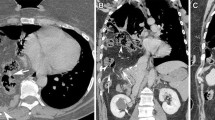Abstract
Diaphragmatic injury is an uncommon but clinically important entity in the setting of trauma. Computed tomography (CT) is widely used to evaluate hemodynamically stable trauma patients. While prior studies have identified CT signs of diaphragm injury in blunt or penetrating trauma, no study has directly compared signs across these two types of injuries. We identified patients with surgically proven diaphragm injuries who underwent CT at presentation. Three reviewers examined each for 12 signs of diaphragm injury, as well as for an overall impression of diaphragm injury. We reviewed a total of 84 patients (37 % blunt trauma, 63 % penetrating). The initial interpreting radiologists discovered 77 % of blunt and 47 % of penetrating injuries (p = 0.01). We found that the majority of signs of diaphragmatic injury were split between those common in blunt trauma and those common in penetrating trauma, with minimal overlap. The presence of at least one blunt injury sign has 90 % sensitivity for diaphragm injury in blunt trauma; the presence of a wound tract traversing the diaphragm has 92 % sensitivity in penetrating trauma. Inter-observer reliability of these signs is also high (κ > 0.65). Penetrating diaphragm injuries present a different spectrum of imaging findings from those in blunt trauma and are underdiagnosed at CT; looking for a wound tract traversing the diaphragm is highly sensitive for diaphragm injury in these cases. Signs of organ or diaphragm fragment displacement are sensitive for blunt diaphragm injuries, consistent with these injuries being caused by increased intra-abdominal pressure.



Similar content being viewed by others
References
Shanmuganathan K, Killeen K, Mirvis SE, White CS (2000) Imaging of diaphragmatic injuries [miscellaneous article]. J Thoracic Imaging 2000(15):104–111
Sangster G et al (2007) Diaphragmatic rupture: a frequently missed injury in blunt thoracoabdominal trauma patients. Emerg Radiol 13:225–230
Clarke DL, Greatorex B, Oosthuizen GV, Muckart DJ (2009) The spectrum of diaphragmatic injury in a busy metropolitan surgical service. Injury 40:932–937
Chen JC, Wilson SE (1991) Diaphragmatic injuries: recognition and management in sixty-two patients. Am Surg 57:810–815
Shah R, Sabanathan S, Mearns AJ, Choudhury AK (1995) Traumatic rupture of diaphragm. Ann Thorac Surg 60:1444–1449
Feliciano DV et al (1988) Delayed diagnosis of injuries to the diaphragm after penetrating wounds. J Trauma 28:1135–1144
Shatney CH, Sensaki K, Morgan L (2003) The natural history of stab wounds of the diaphragm: implications for a new management scheme for patients with penetrating thoracoabdominal trauma. Am Surg 69:508–513
Zierold D, Perlstein J (2001) Penetrating trauma to the diaphragm: natural history and ultrasonographic characteristics of untreated injury in a pig model. Arch Surg 136:32–37
Desir A, Ghaye B (2012) CT of blunt diaphragmatic rupture. Radiographics 32:477–498
Murray JG et al (1996) Acute rupture of the diaphragm due to blunt trauma: diagnostic sensitivity and specificity of CT. AJR Am J Roentgenol 166:1035–1039
Nchimi A et al (2005) Helical CT of blunt diaphragmatic rupture. AJR Am J Roentgenol 184:24–30
Bodanapally UK et al (2009) MDCT diagnosis of penetrating diaphragm injury. Eur Radiol 19:1875–1881
Desser TS et al (2010) The dangling diaphragm sign: sensitivity and comparison with existing CT signs of blunt traumatic diaphragmatic rupture. Emerg Radiol 17:37–44
Shackleton KL, Stewart ET, Taylor AJ (1998) Traumatic diaphragmatic injuries: spectrum of radiographic findings. Radiographics 18:49–59
Chen H-W et al (2010) Computed tomography in left-sided and right-sided blunt diaphragmatic rupture: experience with 43 patients. Clin Radiol 65:206–212
Sliker CW (2006) Imaging of diaphragm injuries. Radiol Clin North Am 44:199–211, vii
Bocchini G, Guida F, Sica G, Codella U, Scaglione M (2012) Diaphragmatic injuries after blunt trauma: are they still a challenge? Emerg Radiol 19:225–235
Demetriades D, Kakoyiannis S, Parekh D, Hatzitheofilou C (1988) Penetrating injuries of the diaphragm. Br J Surg 75:824–826
Murray JA et al (1998) Occult injuries to the diaphragm: prospective evaluation of laparoscopy in penetrating injuries to the left lower chest. J Am Coll Surg 187:626–630
Stein DM et al (2007) Accuracy of computed tomography (CT) scan in the detection of penetrating diaphragm injury. J Trauma 63:538–543
Rees O, Mirvis SE, Shanmuganathan K (2005) Multidetector-row CT of right hemidiaphragmatic rupture caused by blunt trauma: a review of 12 cases. Clin Radiol 60:1280–1289
Leung JC, Nance ML, Schwab CW, Miller WT Jr (1999) Thickening of the diaphragm: a new computed tomography sign of diaphragm injury. J Thorac Imaging 14:126–129
Mueller CF, Pendarvis RW (1994) Traumatic injury of the diaphragm: report of seven cases and extensive literature review. Emerg Radiol 1:118–132
Dreizin D et al (2013) Penetrating diaphragmatic injury: accuracy of 64-section multidetector CT with trajectography. Radiology. doi:10.1148/radiol.13121260
Conflict of Interest
The authors declare that they have no conflict of interest.
Author information
Authors and Affiliations
Corresponding author
Additional information
Mark M. Hammer and Eric Flagg contributed equally to the work.
Electronic supplementary material
Below is the link to the electronic supplementary material.
Supplementary Figure 1
Additional examples of signs of diaphragmatic injury. a 33-year-old male in a motor vehicle collision with surgically proven left-sided diaphragm injury; this case demonstrates the dangling diaphragm sign (arrowhead), intra-thoracic herniation of the stomach, the collar sign (arrow), dependent viscera, and elevated abdominal organs (coronal reformat). b 25-year-old man in a motor vehicle collision with surgically proven bilateral diaphragm injury. This case demonstrates the band sign (arrows), intra-thoracic and dependent viscera, and elevated abdominal organs. c 53-year-old woman in a motor vehicle collision with surgically proven left-sided diaphragm injury; this case demonstrates diaphragmatic discontinuity and focal diaphragm thickening (arrow). d 19-year-old man in a motor vehicle collision with surgically proven left diaphragm injury. Transverse CT image demonstrates diffuse diaphragmatic thickening (arrows) as well as diaphragmatic discontinuity and intra-thoracic herniation of small bowel (PPTX 1,585 kb)
Rights and permissions
About this article
Cite this article
Hammer, M.M., Flagg, E., Mellnick, V.M. et al. Computed tomography of blunt and penetrating diaphragmatic injury: sensitivity and inter-observer agreement of CT Signs. Emerg Radiol 21, 143–149 (2014). https://doi.org/10.1007/s10140-013-1166-0
Received:
Accepted:
Published:
Issue Date:
DOI: https://doi.org/10.1007/s10140-013-1166-0




